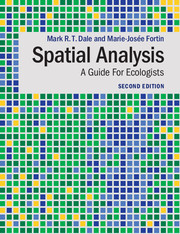Book contents
- Frontmatter
- Dedication
- Contents
- Preface
- 1 Spatial concepts and notions
- 2 Ecological and spatial processes
- 3 Points, lines and graphs
- 4 Spatial analysis of complete point location data
- 5 Contiguous units analysis
- 6 Spatial analysis of sample data
- 7 Spatial relationship and multiscale analysis
- 8 Spatial autocorrelation and inferential tests
- 9 Spatial partitioning: spatial clusters and boundary detection
- 10 Spatial diversity analysis
- 11 Spatio-temporal analysis
- 12 Closing comments and future directions
- References
- Index
10 - Spatial diversity analysis
Published online by Cambridge University Press: 05 September 2014
- Frontmatter
- Dedication
- Contents
- Preface
- 1 Spatial concepts and notions
- 2 Ecological and spatial processes
- 3 Points, lines and graphs
- 4 Spatial analysis of complete point location data
- 5 Contiguous units analysis
- 6 Spatial analysis of sample data
- 7 Spatial relationship and multiscale analysis
- 8 Spatial autocorrelation and inferential tests
- 9 Spatial partitioning: spatial clusters and boundary detection
- 10 Spatial diversity analysis
- 11 Spatio-temporal analysis
- 12 Closing comments and future directions
- References
- Index
Summary
Introduction
The topic of diversity in biological systems, whether called ‘species diversity’, ‘ecological diversity’, ‘biological diversity’, or just ‘biodiversity’, is the topic of literally thousands of scientific articles and is included as a central concept, sometimes the main subject, of many books (Huston 1994; Magurran 2004; Rosenzweig 1995; Sarkar 2009; Magurran & McGill 2010). Informally, diversity is related to the variety of classes or categories represented in a collection of objects. The concept comes up in a number of different areas for biological research including genetics, systematics and evolution, conservation biology, and ecology. Biological diversity in ecological systems is a concept of intense interest and of great theoretical as well as practical importance, which has implications for the coexistence of species and the structure of natural communities as well as for the persistence of species in disturbed systems, the conservation of organisms, and the functioning of the systems in which they occur.
In the ecological literature, much of the discussion of diversity has dealt with what the concept means, or should mean, and how the characteristic is, or should be, measured. Diversity thus includes several aspects which make its discussion complex. As early as 1971, Hurlbert wrote a paper on the ‘nonconcept’ of species diversity, suggesting that the idea had been so abused as to become meaningless and that the term should be abandoned. More recently, Huston (1994, p. 64) commented that ‘Far too much attention has been paid to comparison and criticism of statistical methods for quantifying diversity’. We will try to bring clarity to those parts of the discussion needed for spatial diversity analysis, but it is worth remembering Colwell’s recent reminder that the concept of diversity is “a human construct without any unique mathematical meaning” (Colwell 2009). Our own version of the same warning is that even richness, as one aspect of diversity, is a synthetic variable, and we will return to the implications of this fact within a spatial context.
Information
- Type
- Chapter
- Information
- Spatial AnalysisA Guide For Ecologists, pp. 278 - 318Publisher: Cambridge University PressPrint publication year: 2014
